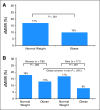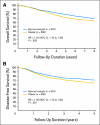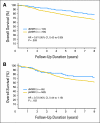Association of obesity with DNA mismatch repair status and clinical outcome in patients with stage II or III colon carcinoma participating in NCCTG and NSABP adjuvant chemotherapy trials
- PMID: 22203756
- PMCID: PMC3269966
- DOI: 10.1200/JCO.2011.39.2563
Association of obesity with DNA mismatch repair status and clinical outcome in patients with stage II or III colon carcinoma participating in NCCTG and NSABP adjuvant chemotherapy trials
Abstract
Purpose: Although the importance of obesity in colon cancer risk and outcome is recognized, the association of body mass index (BMI) with DNA mismatch repair (MMR) status is unknown.
Patients and methods: BMI (kg/m(2)) was determined in patients with TNM stage II or III colon carcinomas (n = 2,693) who participated in randomized trials of adjuvant chemotherapy. The association of BMI with MMR status and survival was analyzed by logistic regression and Cox models, respectively.
Results: Overall, 427 (16%) tumors showed deficient MMR (dMMR), and 630 patients (23%) were obese (BMI ≥ 30 kg/m(2)). Obesity was significantly associated with younger age (P = .021), distal tumor site (P = .012), and a lower rate of dMMR tumors (10% v 17%; P < .001) compared with normal weight. Obesity remained associated with lower rates of dMMR (odds ratio, 0.57; 95% CI, 0.41 to 0.79; P < .001) after adjusting for tumor site, stage, sex, and age. Among obese patients, rates of dMMR were lower in men compared with women (8% v 13%; P = .041). Obesity was associated with higher recurrence rates (P = .0034) and independently predicted worse disease-free survival (DFS; hazard ratio [HR], 1.37; 95% CI, 1.14 to 1.64; P = .0010) and overall survival (OS), whereas dMMR predicted better DFS (HR, 0.59; 95% CI, 0.47 to 0.74; P < .001) and OS. The favorable prognosis of dMMR was maintained in obese patients.
Conclusion: Colon cancers from obese patients are less likely to show dMMR, suggesting obesity-related differences in the pathogenesis of colon cancer. Although obesity was independently associated with adverse outcome, the favorable prognostic impact of dMMR was maintained among obese patients.
Conflict of interest statement
Authors' disclosures of potential conflicts of interest and author contributions are found at the end of this article.
Figures



Similar articles
-
DNA mismatch repair status and colon cancer recurrence and survival in clinical trials of 5-fluorouracil-based adjuvant therapy.J Natl Cancer Inst. 2011 Jun 8;103(11):863-75. doi: 10.1093/jnci/djr153. Epub 2011 May 19. J Natl Cancer Inst. 2011. PMID: 21597022 Free PMC article.
-
Role of Deficient DNA Mismatch Repair Status in Patients With Stage III Colon Cancer Treated With FOLFOX Adjuvant Chemotherapy: A Pooled Analysis From 2 Randomized Clinical Trials.JAMA Oncol. 2018 Mar 1;4(3):379-383. doi: 10.1001/jamaoncol.2017.2899. JAMA Oncol. 2018. PMID: 28983557 Free PMC article.
-
Prognostic impact of deficient DNA mismatch repair in patients with stage III colon cancer from a randomized trial of FOLFOX-based adjuvant chemotherapy.J Clin Oncol. 2013 Oct 10;31(29):3664-72. doi: 10.1200/JCO.2013.48.9591. Epub 2013 Sep 9. J Clin Oncol. 2013. PMID: 24019539 Free PMC article. Clinical Trial.
-
Survival benefit with adjuvant chemotherapy in stage III microsatellite-high/deficient mismatch repair colon cancer: a systematic review and meta-analysis.Sci Rep. 2022 Jan 20;12(1):1055. doi: 10.1038/s41598-022-05065-6. Sci Rep. 2022. PMID: 35058539 Free PMC article.
-
Prognostic and predictive role of DNA mismatch repair status in stage II-III colorectal cancer: A systematic review and meta-analysis.Clin Genet. 2020 Jan;97(1):25-38. doi: 10.1111/cge.13628. Epub 2019 Sep 4. Clin Genet. 2020. PMID: 31432497
Cited by
-
Association of Obesity With Survival Outcomes in Patients With Cancer: A Systematic Review and Meta-analysis.JAMA Netw Open. 2021 Mar 1;4(3):e213520. doi: 10.1001/jamanetworkopen.2021.3520. JAMA Netw Open. 2021. PMID: 33779745 Free PMC article.
-
Comparison of dietary and lifestyle habits among stage III and metastatic colorectal cancer patients: findings from CALGB 89803 and CALGB 80405.Clin Colorectal Cancer. 2013 Jun;12(2):95-102. doi: 10.1016/j.clcc.2012.11.002. Epub 2013 Jan 12. Clin Colorectal Cancer. 2013. PMID: 23317558 Free PMC article.
-
Nutritional Factors during and after Cancer: Impacts on Survival and Quality of Life.Nutrients. 2022 Jul 19;14(14):2958. doi: 10.3390/nu14142958. Nutrients. 2022. PMID: 35889914 Free PMC article. Review.
-
Initial neutrophil lymphocyte ratio is superior to platelet lymphocyte ratio as an adverse prognostic and predictive factor in metastatic colorectal cancer.Med Oncol. 2013 Mar;30(1):439. doi: 10.1007/s12032-012-0439-x. Epub 2013 Jan 10. Med Oncol. 2013. PMID: 23307251
-
Impact of obesity on the survival of patients with early-stage squamous cell carcinoma of the oral tongue.Cancer. 2014 Apr 1;120(7):983-91. doi: 10.1002/cncr.28532. Epub 2014 Jan 21. Cancer. 2014. PMID: 24449483 Free PMC article.
References
Publication types
MeSH terms
Grants and funding
LinkOut - more resources
Full Text Sources
Medical

